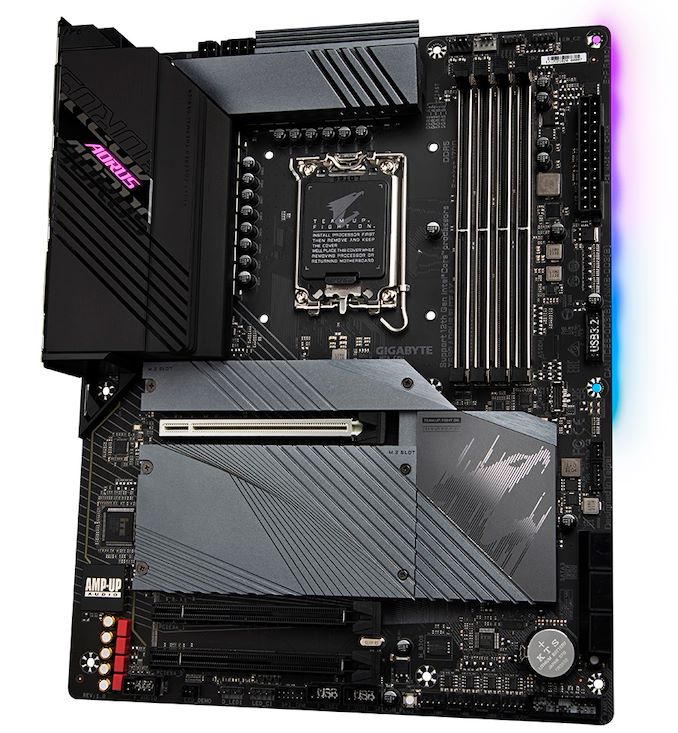The Intel Z690 Motherboard Overview (DDR5): Over 50+ New Models
by Gavin Bonshor on November 9, 2021 9:00 AM ESTGIGABYTE Z690 Aorus Elite AX & Elite
The Elite series is a part of GIGABYTE's Aorus gaming series and represents the bridge between its mid-range and entry-level models. The GIGABYTE Z690 Aorus Elite AX and Z690 Aorus Elite both feature the same core feature set, while the AX model includes an additional Intel Wi-Fi 6 CNVi. Looking at the design, GIGABYTE has gone with a primarily black layout with a dark silver contrasting aesthetic. There is a small element of RGB LED lighting built into the rear panel cover, with a strip creating an underglow effect on the right-hand side of the board.
Dominating the lower section of the board are the PCIe slots, with one full-length PCIe 5.0 x16 and two full-length PCIe 3.0 x4 slots. Sandwiched in between and just above the PCIe 5.0 x16 slot are the board's M.2 slots, with a combined total of four PCIe 4.0 x4 M.2 slots. GIGABYTE also includes six SATA ports that support Intel RAID 0, 1, 5, and 10 arrays. For memory, there's a total of four memory slots with support for DDR5-6000 and a maximum combined capacity of 128 GB.

The GIGABYTE Z690 Aorus Elite AX rear panel with Wi-Fi 6
On the rear panel of the Z690 Aorus Elite AX DDR4 model, GIGABYTE includes an Intel AX201 Wi-FI 6 CNVi, while the standard Elite omits this. Everything else is shared across both models including one USB 3.2 G2x2 Type-C, two USB 3.2 G2 Type-A, three USB 3.2 G1 Type-A, and four USB 2.0 ports. The integrated audio offers two 3.5 mm audio jacks and S/PDIF optical output, while an HDMI and DisplayPort video output pairing allows users to utilize Intel's integrated graphics. Finishing off the rear panel is an Intel I225-V 2.5 GbE controller.











126 Comments
View All Comments
GeoffreyA - Saturday, November 13, 2021 - link
Certainly, there are tradeoffs, keeping a socket; but, as Mr. Tuvok would say, "Ryzen, you are an unending source of astonishment." There was a time when sockets even took CPUs from different manufacturers. I remember my Socket 7 motherboard, though I never tried it, could take a K5 and some Cyrix CPUs as well. Those 5x something, something. How things have changed.A short-lived socket can be a pain in the behind too. I was one of those unlucky folk who ended up with Socket 754 and missed out on dual-channel DDR and a long upgrade path. In any case, that computer went kaput after four years.
Oxford Guy - Wednesday, November 10, 2021 - link
Overclocking is for employees of motherboard companies.ECC RAM support should have been a standard feature from the beginning. Apple offered it on the Lisa in ‘83 and consumer computing has gone backward since.
Doublers, though... aren’t a bad thing as long as they’re implemented well — as I understand it. Better to have a good doubler implementation than a weak individual phase system. The main thing is to have a board meet the minimum spec for reliable (i.e. not overheating and/or failing) long-term support of its supported CPUs. Anything beyond that is unnecessary.
GeoffreyA - Saturday, November 13, 2021 - link
The problem with doublers is, they over-use it as a marketing technique to give the impression that a certain board has a large amount of phases.Oxford Guy - Saturday, November 13, 2021 - link
Weak phases with a mediocre/poor regulator aren’t necessarily better than ‘marketing phases’ via the use of doublers. That’s the case when the doublers are used a correctly.There are a lot of shenanigans, though — like not even utilizing the doubler fully but counting it as the doubling of phases. I also recall that one of the big tricks was putting extra chokes on the board to make it look like there are more phases.
GeoffreyA - Sunday, November 14, 2021 - link
Quite right, and one of the reasons why people have got to read a proper analysis of the VRM, or take a look at the lists on hardwareluxx for example.t.s - Tuesday, November 9, 2021 - link
Wish Intel go with their atv12vo. Or like business lines from HP, Dell, Lenovo, etc. 6 or 8 pin.shabby - Tuesday, November 9, 2021 - link
Mobo prices will go up even more, screw that.meacupla - Tuesday, November 9, 2021 - link
In the long term, I think the cost for ATX12VO will be cheaper.ATX12VO PSU will be cheaper than a comparable quality ATX PSU.
The BoM for 12V to 5V and 12V to 3.3V converters would go down, if mobo makers decide to stick to a single, standardized design.
With the way things are looking, electricity prices are unlikely to go down and continue to go up.
DigitalFreak - Tuesday, November 9, 2021 - link
All ATX12VO is doing is shifting the cost from the PSU to the motherboard.Wrs - Wednesday, November 10, 2021 - link
If mobo makers can stick to one design why can't PSU makers? They already conform to ATX.ATX 12 VO increases costs for piecemeal upgraders because of the simple observation that PSUs outlive motherboards. The question would be whether the power savings are worth it. For prebuilts they're comparing power savings to 0 net component cost so 12VO is already the norm.